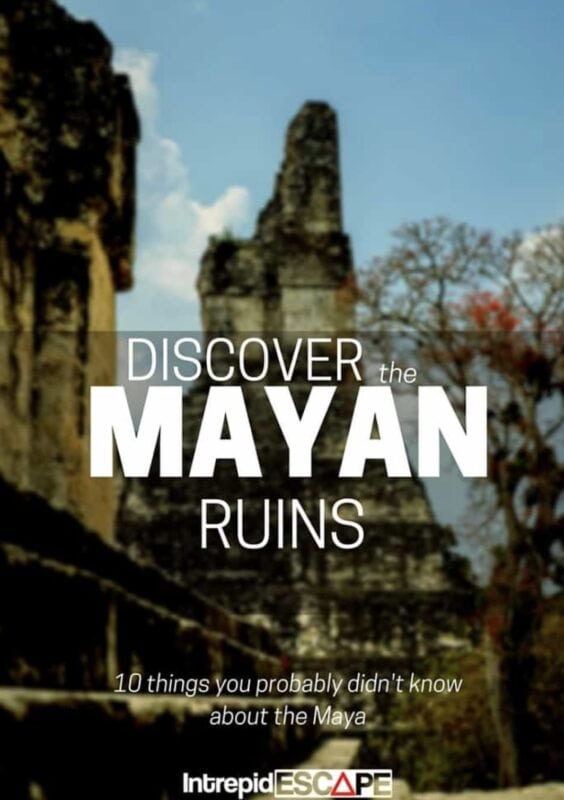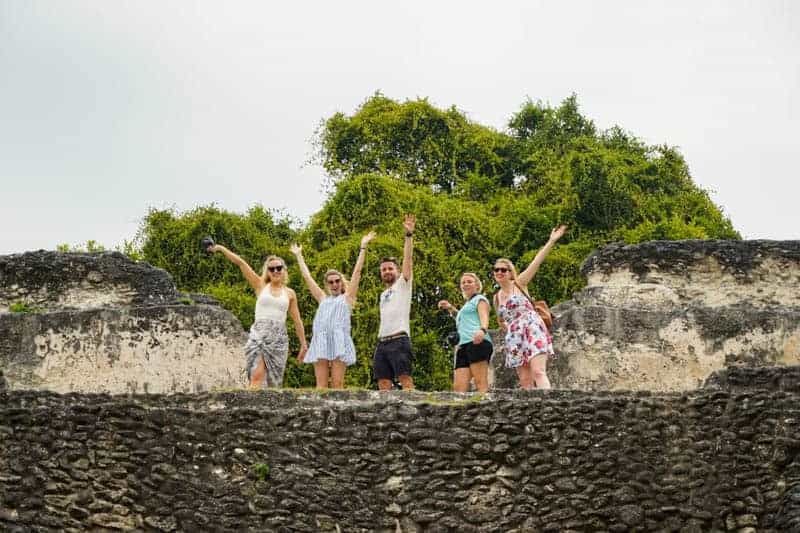Page Contents
If you’re like me, you probably know little about the Maya and their history. I knew they were an advanced civilisation, and I knew they existed in Central America, but that’s more or less it.
That is until a recent visit to Guatemala and Belize to see the Mayan Ruins for myself – And I discovered many interesting facts about Mayan Ruins that I want to share in this guide.
My eyes were opened to a world I didn’t know existed, thousands of years ago, where one of the most fascinating, intelligent and advanced civilisations thrived, and then mysteriously demised.
Through a combination of extensive note-taking, guided tours and online research, I’ve put together a brief fact sheet of the Maya. These are what I consider the 10 most interesting facts behind their history, but it doesn’t tell the tale. To do that you have to go to Central America and see it for yourself!
10 facts about Mayan Ruins you probably didn’t know.

10 Facts About Mayan Ruins
#1: Excavation
Approximately 80% of Mayan ruins remain hidden underground or are enshrouded by dense jungle, awaiting excavation.
This vast unexplored heritage, spanning across Mesoamerica, holds untold stories of ancient Mayan civilization.
Until significant funding and resources are allocated, these secrets will remain buried, highlighting the need for increased archaeological efforts to uncover and preserve the rich history and culture of the Maya.
#2: Geography
The Mayan world existed in Mesoamerica, a term used for Mexico and Central America before the Spanish conquered it in the 16th Century. Today the ruins are found in 5 countries; Guatemala, Belize, Mexico, El Salvador and Honduras.
Each of these countries today shares a part of the rich Mayan heritage, with ruins that tell the tale of a complex society that was deeply connected to its geographical surroundings.
#3: Zero
The Maya figured out the concept of zero a thousand years before the Europeans.
This breakthrough was integral to their sophisticated calendrical systems and astronomical calculations, demonstrating their advanced mathematical and scientific knowledge.
The concept of zero allowed the Maya to calculate astronomical events, plan agricultural activities, and develop a complex society based on an intricate understanding of time and space.
#4: History
Maya settlements dating back to 1800 BC mark the beginning of their civilization, with historians categorizing the period up to 250 AD as Early Maya.
The era from 250-900 AD is known as the Classic Maya or the Golden Age, a time of remarkable achievements in architecture, astronomy, and art.
This period witnessed the construction of majestic temples and pyramids, a testament to the Maya’s engineering prowess and their deep religious beliefs.
#5: Astronomy
The Maya were exceptional astronomers, creating agricultural calendars based on a 365-day year.
Their ability to track the sun and moon with incredible precision speaks to their advanced understanding of celestial cycles.
This knowledge was crucial for agriculture, religious ceremonies, and the planning of monumental constructions, aligning them with celestial events to reflect their cosmological beliefs.
#6: Writing
They invented a writing system in 700 BC. Only four other cultures did this.
By 700 BC, the Maya had developed a unique writing system, an achievement shared with only four other cultures globally.
This system, consisting of glyphs that represented sounds and words, was used to record their history, beliefs, and scientific knowledge.
Despite the destruction of much of their written work, the surviving texts remain a crucial window into the ancient Maya world, offering insights into their sophisticated society.
#7: Population
During the Classic period, the Maya civilization expanded to include over 40 cities, each with populations ranging from 5,000 to 50,000 inhabitants.
The total population is believed to have reached around 2 million people. This demographic expansion underscores the Maya’s ability to sustain large populations through advanced agricultural techniques, trade networks, and urban planning, showcasing their complex social and economic systems.
#8: Books
Tikal, a major Mayan capital, boasted a vibrant cultural life by 600 AD, with amenities like a library filled with thousands of books, a sports stadium, schools, and hospitals.
Today, only four Mayan codices survive, offering a glimpse into their vast intellectual achievements.
The loss of the majority of their literature to Spanish conquest and religious zealotry has left a void in understanding the full breadth of Mayan knowledge and culture.
#9: Religion
Mayan people worshipped various Gods related to nature, such as the God of the Sun, the Moon, Rain and Corn.
The Kings of the cities claimed to be related to the Gods, but really they were just armed with intelligence passed on from ancestors.
This connection to the divine was not just a political tool but reflected the Maya’s profound respect for the natural world, which was central to their cosmology, daily life, and understanding of the universe.
#10: Demise
The sudden abandonment of classic Mayan cities around 900 AD remains one of history’s mysteries.
Despite numerous theories ranging from drought to societal collapse, the exact cause of their decline is still debated.
This enigmatic end to a flourishing civilization underscores the complexity of historical and environmental factors influencing societal change and highlights the fragility of even the most advanced societies in the face of environmental and internal challenges.
Explore the Mayan Ruins
When it comes to exploring the Mayan Ruins, we started in Tikal the capital of the Classic Era. Go big or go home! Guatemala is the centre of the geographical region the Maya flourished in.
We stayed in Isla de Flores, about an hour’s drive from Tikal. It’s an island in the middle of Lago Peten Itza, the second largest lake in Guatemala. It’s a great base for getting to Tikal, and I’d suggest a little time to explore the lake and the town.
Tikal is a National Park and UNESCO World Heritage site, and it’s huge! Allow plenty of time and get a guide, if you’re lucky you’ll spot some wildlife in the rainforest too.
The next Mayan site I saw was Xunantunich (shoe-nan-toon-itch) in Belize, it’s a lot smaller than Tikal and overlooks the Mopan River valley.
A day of hiking in Tikal was exhausting in the heat and humidity, so this is much more manageable. There’s also a lot less rainforest covering the temples in Xunantunich, so you can get a real sense of how the Maya lived.
But that also meant there’s a lot less to see. Either way I’d strongly recommend a visit, and climb to the top of el Castillo for spectacular views.
More Mayan Ruins to Visit
Here are some other incredible Mayan Ruins you’ll want to visit, and they’re all super interesting:
Chichen Itza, Mexico – another Mayan capital, although I hear this get very packed with tourists with 1.2 million visitors a year. The appeal for me is the different style demonstrating how the Maya evolved over the years
Palenque, Mexico – near the Usumacinta River in Chiapas you’ll find another Mayan city, and it’s believed only 10% has been uncovered! There are a lot of unique buildings here that we can’t really see elsewhere.
Copan, Honduras – not far from Guatemala, it’s believed it flourished due to the fertile soil around the Copan River. The architecture is apparently very well preserved here and is a must visit for Maya enthusiasts (like me!).
Conclusion – Facts About Mayan Ruins
The Mayan ruins offer a fascinating glimpse into an advanced civilization known for its astronomical precision, mathematical innovations, and complex societal structures.
Despite the mystery of their decline and the loss of their literature, the surviving ruins continue to intrigue and educate, and I’m confident you’ll love visiting.
They remind us of the impermanence of civilizations and the importance of preserving and learning from our collective past.
So as a newly found Mayan history geek, I’m keen to see and learn more about their fascinating history. Do you have any facts to add to the above? What was your favourite Mayan Ruins site? I’d love to hear about it in the comments below…
Support Intrepid Escape by adding this article on Pinterest to read it later and share it with your friends!
PS: these facts were taken mostly from leaflets & tour guides, if you are a historian and find some slight errors, then sorry, a lot of the Mayan history is open to interpretation.










Great pictures! Ruins look so surreal
Thanks Luke they are so impressive, you’d love it 🙂
Pingback: Plan the Perfect 7 Day Guatemala Itinerary in 2024 - Intrepid Escape